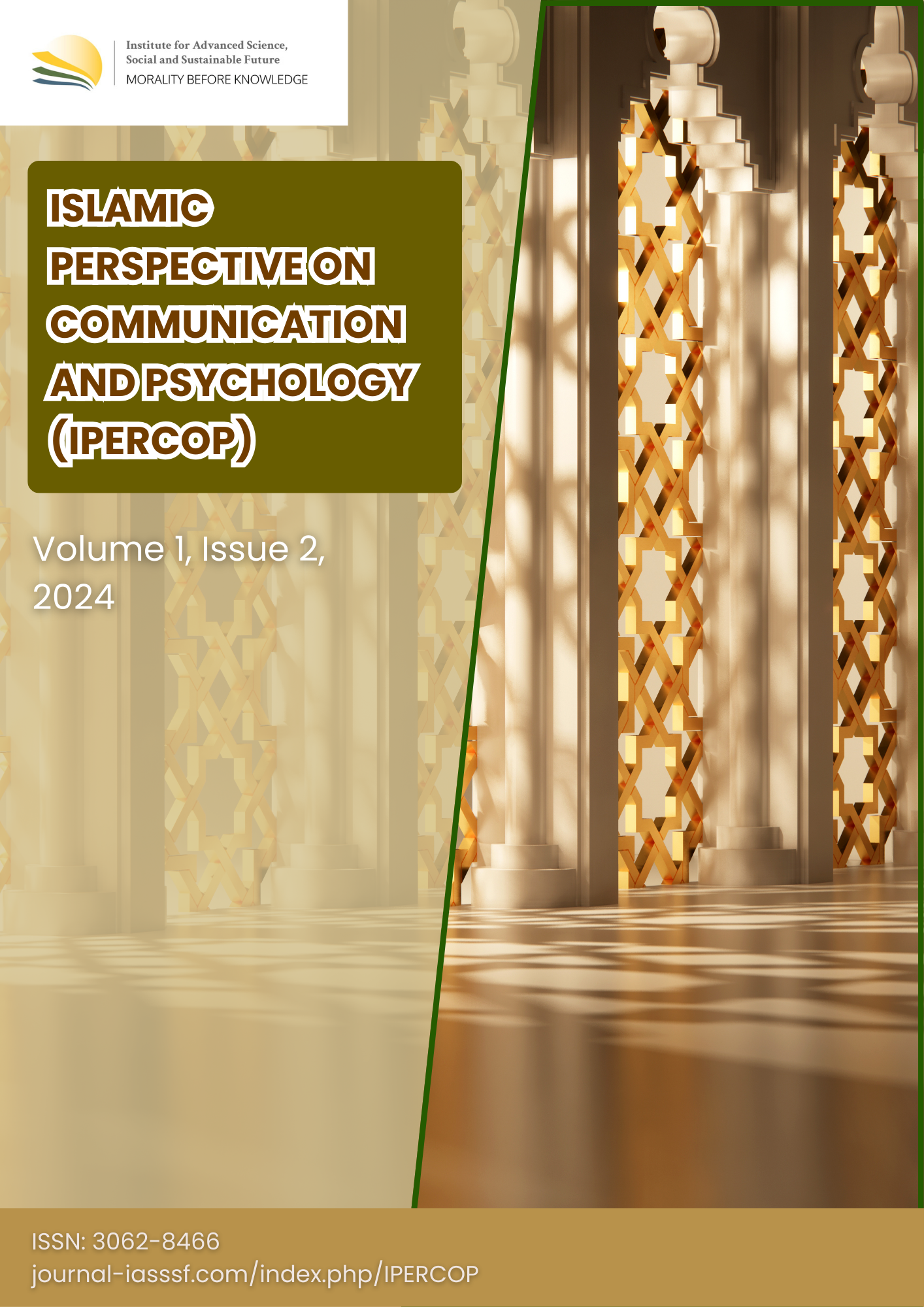The impact of personalized advertising on instagram toward brand loyalty: A study of gen z consumers
DOI:
https://doi.org/10.61511/ipercop.v1i2.2024.1271Keywords:
brand attachment, brand loyalty, consumer brand engagement, perceived personalization, perceived qualityAbstract
Background: In the digital era, social media has become an essential tool for companies to promote their brands. Social media platforms, such as Instagram, offer advertisers the ability to personalize advertisements to align more closely with target audience preferences. This research examines whether personalized advertising can enhance perceived quality and brand loyalty among Generation Z consumers exposed to brand advertisements on Instagram. Methods: Data were collected from 310 Instagram users aged 16–25 who had encountered a personalized advertisement on Instagram. Structural equation modeling (SEM) analysis was conducted using AMOS 22 software to evaluate the relationships between perceived personalization, consumer brand engagement, brand attachment, perceived quality, and brand loyalty. Findings: The results indicate that perceived personalization positively influences consumer brand engagement and brand attachment. Both consumer brand engagement and brand attachment subsequently have a positive impact on perceived quality and brand loyalty. This confirms the role of personalized advertising in building stronger consumer connections with brands on social media. Conclusion: The findings highlight the importance of personalization in social media advertising as a strategy to increase consumer engagement, attachment, and ultimately loyalty and perceived quality toward brands. Companies aiming to appeal to Generation Z can leverage personalized advertisements on Instagram to foster stronger brand relationships and consumer loyalty. Novelty/Originality of this article: This study adds to the existing literature by focusing specifically on Generation Z’s responses to personalized advertising on Instagram, exploring how perceived personalization affects engagement, attachment, quality perception, and brand loyalty in this demographic. This provides valuable insights for marketers seeking to tailor their strategies to better connect with Generation Z consumers in digital environments.
References
Aaker, D. A. (2009). Managing brand equity: Capitalizing on the value of a brand name. simon and schuster.
Aaker, D. A., & Keller, K. L. (1990). Consumer Evaluations of Brand Extensions. Journal of Marketing, 54(1), 27-41. https://doi.org/10.2307/1252171
Agius, A. (2017, October 17). How to Create Brand Loyalty Before Your Customer Even Makes a Purchase. https://www.jeffbullas.com/how-to-create-brand-loyalty. Retrieved July 18, 2020
Anderson, J. C., & Gerbing, D. W. (1988). Structural equation modeling in practice: A review and recommended two-step approach. Psychological bulletin, 103(3), 411. https://doi.org/10.1037/0033-2909.103.3.411
Ansari, A., & Mela, C. F. (2003). E-customization. Journal of marketing research, 40(2), 131-145. https://doi.org/10.1509/jmkr.40.2.131.19224
Aron, A., & Westbay, L. (1996). Dimensions of the prototype of love. Journal of personality and social psychology, 70(3), 535. https://doi.org/10.1037/0022-3514.70.3.535
Avnet, T., & Higgins, E. T. (2006). How regulatory fit affects value in consumer choices and opinions. Journal of Marketing research, 43(1), 1-10. https://doi.org/10.1509/jmkr.43.1.1
Baird, C. H., & Parasnis, G. (2011). From social media to social customer relationship management. Strategy & leadership, 39(5), 30-37. https://doi.org/10.1108/10878571111161507
Blasco-Arcas, L., Hernandez-Ortega, B. I., & Jimenez-Martinez, J. (2016). Engagement platforms: The role of emotions in fostering customer engagement and brand image in interactive media. Journal of Service Theory and Practice, 26(5), 559-589. https://doi.org/10.1108/JSTP-12-2014-0286
Boulding, W., & Kirmani, A. (1993). A consumer-side experimental examination of signaling theory: do consumers perceive warranties as signals of quality?. Journal of consumer research, 20(1), 111-123. https://doi.org/10.1086/209337
Bowlby, J. (1977). The Making and Breaking of Affectional Bonds. British Journal of Psychiatry. https://doi.org/10.1192/bjp.130.5.421
Brennan, K. A., Clark, C. L., & Shaver, P. R. (1998). Self-report measurement of adult attachment: An integrative overview. In Attachment theory and close relationships. New York, NY, US: Guilford Press.[Google Scholar].
Brodie, R. J., Ilic, A., Juric, B., & Hollebeek, L. (2013). Consumer engagement in a virtual brand community: An exploratory analysis. Journal of business research, 66(1), 105-114. https://doi.org/10.1016/j.jbusres.2011.07.029
Chaudhuri, A., & Holbrook, M. B. (2001). The chain of effects from brand trust and brand affect to brand performance: the role of brand loyalty. Journal of marketing, 65(2), 81-93. https://doi.org/10.1509/jmkg.65.2.81.18255
Chu, S. C., & Kim, Y. (2011). Determinants of consumer engagement in electronic word-of-mouth (eWOM) in social networking sites. International journal of Advertising, 30(1), 47-75. https://doi.org/10.2501/IJA-30-1-047-075
DelVecchio, D., Henard, D. H., & Freling, T. H. (2006). The effect of sales promotion on post-promotion brand preference: A meta-analysis. Journal of retailing, 82(3), 203-213. https://doi.org/10.1016/j.jretai.2005.10.001
Duczeminski, M. (2017, December 7). The Pre-Purchase Magic: Nurture Loyalty in Your Future Customers. https://postfunnel.com/pre-purchase-magic-nurture-loyalty-future-customers. Retrieved July 18, 2020
Epstein, J. (2015, April 25). 3 Ways to Build Brand Loyalty -- Before They Buy!. https://www.getambassador.com/blog/3-ways-to-build-brand-loyalty-before-they-buy. Retrieved July 18, 2020
Fetscherin, M., & Heinrich, D. (2015). Consumer brand relationships research: A bibliometric citation meta-analysis. Journal of Business Research, 68(2), 380-390. https://doi.org/10.1016/j.jbusres.2014.06.010
Field, A. (2005) Reliability analysis. In Field, A., Ed., Discovering Statistics Using spss. 2nd Edition. Sage.
Guo, J., & Sun, C. (2004). Global electronic markets and global traditional markets. Electronic Markets, 14(1), 4-12. https://doi.org/10.1080/1019678042000175252
Hair, J. F., Black, W. C., Babin, B. J., & Anderson, R. E. (2014). Multivariate Data Analysis Seventh Edition. In Pearson New International. https://doi.org/10.1007/978-3-319-01517-0_3
Hill, R. P., & Stamey, M. (1990). The homeless in America: An examination of possessions and consumption behaviors. Journal of consumer research, 17(3), 303-321. https://doi.org/10.1086/208559
Hogg, R. V., & Tanis, E. A. (2005). Probability of Statistical Inference. 7th Edition. Pearson.
Hollebeek, L. D., Glynn, M. S., & Brodie, R. J. (2014). Consumer brand engagement in social media: Conceptualization, scale development and validation. Journal of interactive marketing, 28(2), 149-165. https://doi.org/10.1016/j.intmar.2013.12.002
Hootsuite & We are Social. (2020). Indonesian Digital Report 2020. Retrieved March 15, 2020.
Jacoby, J., Olson, J. C., & Haddock, R. A. (1971). Price, brand name, and product composition characteristics as determinants of perceived quality. Journal of applied psychology, 55(6), 570. https://doi.org/10.1037/h0032045
Jahn, B., & Kunz, W. (2012). How to transform consumers into fans of your brand. Journal of service management, 23(3), 344-361. https://doi.org/10.1108/09564231211248444
Kramer, T., Spolter-Weisfeld, S., & Thakkar, M. (2007). The effect of cultural orientation on consumer responses to personalization. Marketing Science, 26(2), 246-258. https://doi.org/10.1287/mksc.1060.0223
Lavie, T., Sela, M., Oppenheim, I., Inbar, O., & Meyer, J. (2010). User attitudes towards news content personalization. International journal of human-computer studies, 68(8), 483-495. https://doi.org/10.1016/j.ijhcs.2009.09.011
Li, C. (2016). When does web-based personalization really work? The distinction between actual personalization and perceived personalization. Computers in human behavior, 54, 25-33. https://doi.org/10.1016/j.chb.2015.07.049
Luarn, P., & Lin, H. H. (2003). A customer loyalty model for e-service context. J. Electron. Commer. Res., 4(4), 156-167. http://ojs.jecr.org/jecr/sites/default/files/04_4_p03_0.pdf
Mangleburg, T. F., Doney, P. M., & Bristol, T. (2004). Shopping with friends and teens’ susceptibility to peer influence. Journal of retailing, 80(2), 101-116. https://doi.org/10.1016/j.jretai.2004.04.005
Manrai, L. A., & Manrai, A. K. (2001). Marketing opportunities and challenges in emerging markets in the new millennium: a conceptual framework and analysis. International Business Review, 10(5), 493-504. https://doi.org/10.1016/S0969-5931(01)00029-4
Maslowska, E., Smit, E. G., & Van den Putte, B. (2016). It is all in the name: A study of consumers' responses to personalized communication. Journal of Interactive Advertising, 16(1), 74-85. https://doi.org/10.1080/15252019.2016.1161568
McCrindle. (2013). Generation Z Defined: Global, Visual, Digital. https://mccrindle.com.au/insights/blogarchive/generation-z-defined-global-visual-digital. Retrieved July 15, 2020
McKinsey & Company. (2018, November 12). ‘True Gen’: Generation Z and its implications for companies. https://www.mckinsey.com/industries/consumer-packaged-goods/our-insights/true-gen-generation-z-and-its-implications-for-companies. Retrieved July 15, 2020
Mick, D. G., & DeMoss, M. (1990). Self-gifts: Phenomenological insights from four contexts. Journal of Consumer Research, 17(3), 322-332. https://doi.org/10.1086/208560
Montgomery, A. L., & Smith, M. D. (2009). Prospects for Personalization on the Internet. Journal of Interactive Marketing, 23(2), 130-137. https://doi.org/10.1016/j.intmar.2009.02.001
NapoleonCat (2020). Instagram Users in Indonesia, May 2020. https://napoleoncat.com/stats/instagram-users-in-indonesia/2020/05. Retrieved June 16, 2020
Nielsen. (2016, Oktober 19). Gen Z: Konsumen Potensial Masa Depan. https://www.nielsen.com/id/en/press-releases/2016/gen-z-konsumen-potensial-masa-depan. Retrieved July 15, 2020
Nikhashemi, S. R., Valaei, N., & Tarofder, A. K. (2017). Does brand personality and perceived product quality play a major role in mobile phone consumers’ switching behaviour?. Global Business Review, 18(3), S108-S127. https://doi.org/10.1177/0972150917693155
Petroshius, S. M., & Monroe, K. B. (1987). Effect of product-line pricing characteristics on product evaluations. Journal of Consumer Research, 13(4), 511-519. https://doi.org/10.1086/209084
Sashi, C. M. (2012). Customer engagement, buyer‐seller relationships, and social media. Management decision, 50(2), 253-272. https://doi.org/10.1108/00251741211203551
Schouten, J. W., & McAlexander, J. H. (1995). Subcultures of consumption: An ethnography of the new bikers. Journal of consumer research, 22(1), 43-61. https://doi.org/10.1086/209434
Shanahan, T., Tran, T. P., & Taylor, E. C. (2019). Getting to know you: Social media personalization as a means of enhancing brand loyalty and perceived quality. Journal of Retailing and Consumer Services, 47, 57-65. https://doi.org/10.1016/j.jretconser.2018.10.007
Sheth, J. N. (1974). Measurement of advertising effectiveness: some theoretical considerations. Journal of Advertising, 3(1), 6-11. https://doi.org/10.1080/00913367.1974.10672505
Slater, J. S. (2001). Collecting Brand Loyalty: A Comparative Analysis of How Coca-Cola and Hallmark Use Collecting Behavior to Enhance Brand Loyalty. Advances in consumer research, 28(1).
Song, J. H., Kim, H. Y., Kim, S., Lee, S. W., & Lee, J. H. (2016). Effects of personalized e-mail messages on privacy risk: Moderating roles of control and intimacy. Marketing Letters, 27, 89-101. https://doi.org/10.1007/s11002-014-9315-0
Tam, K. Y., & Ho, S. Y. (2006). Understanding the impact of web personalization on user information processing and decision outcomes. MIS quarterly, 865-890. https://doi.org/10.2307/25148757
Thomson, M., MacInnis, D. J., & Whan Park, C. (2005). The ties that bind: Measuring the strength of consumers’ emotional attachments to brands. Journal of consumer psychology, 15(1), 77-91. https://doi.org/10.1207/s15327663jcp1501_10
Van Lange, P. A., Rusbult, C. E., Drigotas, S. M., Arriaga, X. B., Witcher, B. S., & Cox, C. L. (1997). Willingness to sacrifice in close relationships. Journal of personality and social psychology, 72(6), 1373. https://doi.org/10.1037/0022-3514.72.6.1373
Vesanen, J., & Raulas, M. (2006). Building bridges for personalization: A process model for marketing. Journal of Interactive marketing, 20(1), 5-20. https://doi.org/10.1002/dir.20052
Wedel, M., & Kannan, P. K. (2016). Marketing analytics for data-rich environments. Journal of marketing, 80(6), 97-121. https://doi.org/10.1509/jm.15.0413
Whan Park, C., Maclnnis, D. J., Priester, J., Eisingerich, A. B., & Lacobucci, D. (2010). Brand attachment and brand attitude strength: Conceptual and empirical differentiation of two critical brand equity drivers. Journal of Marketing, 74(6), 1-17. https://doi.org/10.1509/jmkg.74.6.1
Zeithaml, V. A. (1988). Consumer perceptions of price, quality, and value: a means-end model and synthesis of evidence. Journal of marketing, 52(3), 2-22. https://doi.org/10.2307/1251446
Zhang, K. Z., Benyoucef, M., & Zhao, S. J. (2015). Consumer participation and gender differences on companies’ microblogs: A brand attachment process perspective. Computers in Human Behavior, 44, 357-368. https://doi.org/10.1016/j.chb.2014.11.068
Downloads
Published
Issue
Section
Citation Check
License
Copyright (c) 2024 Islamic perspective on Communication and Psychology

This work is licensed under a Creative Commons Attribution 4.0 International License.















